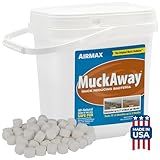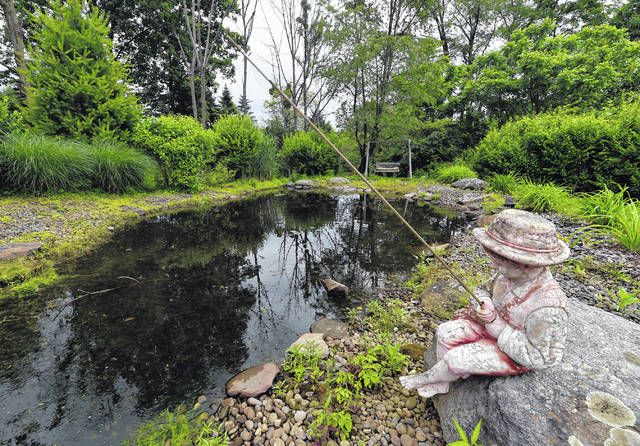Best Treatments for Pond Envy to Buy in December 2025

API POND-ZYME SLUDGE DESTROYER Pond Cleaner With Natural Pond Bacteria And Barley, 1-Pound Container
-
NATURAL BACTERIA ELIMINATE FISH WASTE AND POND SLUDGE EFFECTIVELY.
-
BREAKS DOWN DEAD ALGAE, LEAVES, AND CLIPPINGS FOR A CLEANER POND.
-
REDUCES MAINTENANCE-USE TWICE WEEKLY FOR QUICK RESULTS!



PondWorx Pond Bacteria - Formulated for Large Ponds, Water Features and Safe for Koi - Gallon
- INSTANTLY BOOSTS BENEFICIAL BACTERIA FOR FAST POND HEALTH!
- SAFE FOR ALL WATER FEATURES - FISH, PLANTS, AND RECREATION READY!
- EASY APPLICATION ENSURES QUICK RESULTS FOR A THRIVING ECOSYSTEM!



LMJP Muck Reducer - 5LB Natural Sludge Solution Tablets for Ponds & Lakes, Away Muck & Odor Control, Safe for Aquatic Life, Wildlife & Recreation, Treats Up to 30,000 Sq Ft
-
REDUCE POND MUCK BY 2 INCHES MONTHLY WITH ENZYME-RICH TABLETS.
-
100% NATURAL AND SAFE FOR FISH, WILDLIFE, AND FAMILY PEACE OF MIND.
-
TREATS UP TO 6,000 SQ FT; ENJOY FRESH, CLEAR WATER ALL YEAR ROUND!



Airmax MuckAway Natural Beneficial Bacteria for Outdoor Ponds & Lakes, Muck, Sludge & Noxious Odor Solution, Easy to use Enzyme Tablets, Cleaner Beach & Shoreline, Fish, Pet & Wildlife Safe, 8 Scoops
- PROVEN 20+ YEAR INDUSTRY LEADER IN POND MUCK REDUCTION.
- REMOVES 2 OF MUCK MONTHLY WITH ALL-NATURAL, SAFE BACTERIA.
- ELIMINATES FOUL ODORS WHILE ENHANCING POND HEALTH AND WILDLIFE.


Incorporation of the element of water into residential landscaping is not a new idea. Ancient fountains were found in the ruins of Pompeii and one only has to witness the extravagantly crafted fountains of Versailles to realize the importance 17th-century France placed on water in the garden. Perhaps ancient Oriental cultures were the first to use the element of water in landscape design. The roots to our modern koi ponds are richly imbedded in Japan while the roots of our water gardens are probably more from Europe and more specifically the United Kingdom. It was in these areas of the world where the first cases of Pond Fever were reported.
Pond Fever afflicts more people in the world today than Disco Fever did in the 70’s. It has no economical or racial boundaries and flourishes in areas with as little as a few months of warm weather each year though we generally experience more cases in populations located in warmer climates.
One knows he has pond fever when…
…he has an uncontrollable desire to dig up the backyard.
…he spends sleepless hours surfing the net using search words such as “pond”, “koi”, and “pump”.
…he dreams up ways to hide the cost of the project from his spouse.
…he begins thinking boulders are beautiful.
…he gets excited when he meets someone who has a pond.
The US is one of the latest countries to report a sharp rise in the number of cases of pond fever. It was first reported in Hawaii and the West Coast area where the weather is warm most of the year. We suspect this strain originated in Japan. Pond Fever in the US has spread respectively to the Eastern, Southeastern and Midwest United States. Meanwhile, the fever is spreading rapidly throughout other countries like Canada and Australia. At the rate we’re going, it’s possible that within another five years we’ll see a pond in every neighborhood.
Pond Fever is a communicable disease. One evening spent by the neighbor’s pond is enough to spread the fever. It only takes a month or so before another new pond is built and, as the fever runs its course, the owner of the new pond feels the urge to show it off by hosting a dinner party for all his friends, thus repeating the cycle!
Often not all members of the family will contract Pond Fever. There have been cases where the spouse will become immune. This can be an obstacle within a marriage, even within the most loving family. Spouses often disagree on views of how the pond should be built and maintained. Children may not understand their parent’s need for more filtration. They may hide on Sunday afternoons to avoid pond-cleaning chores or dodge the pond at fish-feeding time. From case studies, it’s been documented that some children contract the fever but hide the symptoms from their parents. They run from the chores but, when they think no one is watching, slip their friends into the backyard to see the koi and goldfish.
Pond Fever doesn’t have to be the end of life as we know it. Many people live for years without complications. The fever can be kept at bay unless one loses control of its symptoms. One knows he’s totally lost control of the fever when he exhibits signs of “Pond Envy”.
Pond Envy is a complication of Pond Fever that can lead not only to insanity but also debt and divorce. It’s when one is never satisfied with the size of his pond and is usually triggered by the sight of one that is bigger or better built. An early sign of Pond Envy is when one begins to think up ways to extend his own or to build another. The disease doesn’t manifest itself until he takes action.
A person afflicted with Pond Envy will justify his actions by making up excuses. He may say any or all of the following:
“My fish are too large for this pond.”
“I wish I had built it bigger.”
“I’ve got to make it deeper. There’s predators out there, you know!”
“I made too many mistakes on this one. I need to tear it up and start over.”
“Ya’ gotta’ see Bob’s pond. It’s 10,000 gallons!”
“I think I’ll build another one just for the fish.”
There are presently no vaccines available to prevent the disease from spreading since exposure to the disease, even in the smallest of amounts, can trigger a full-fledged outbreak. The best method of treatment is to constantly monitor anyone afflicted with the disease to prevent it from developing into Pond Envy. Like Herpes, Pond Fever can be controlled.
Therapy and support groups are not good options for those who have Pond Fever as it contributes to the development of Pond Envy. One of the symptoms of Pond Fever is the need to talk about one’s pond, therefore, a support group sitting around talking about ponds can trigger an eruption of the disease and further along the development of Pond Envy!
Water garden centers are known carriers of the disease and the owners literally eaten up with Pond Envy. These people’s lives are consumed with everything pond and, not only do they have Pond Envy, they are guilty of purposely trying to spread the disease! Little frog ornaments and paintings of koi and water lilies are found in their homes. They hoard the best koi and goldfish to add to their “personal collection” although their own ponds are often neglected and in need of attention because they are too busy spreading the disease to tend to their own private needs. These people, however, should not be shunned by society. They should be pitied!
The Doc’s advice for the treatment of Pond Envy is to hide the checkbook and lock the afflicted individual away until he comes to his senses - or, if all else fails, - give in to him - even take him to a water garden center and let him do his thing until he wears himself out. It could save your marriage.
